European Windows Boost U.S. Performance and Design
Enhancing design flexibility and bringing performance to the next level with European windows
![]() Continuing Education
Continuing Education
Use the following learning objectives to focus your study while reading this month’s Continuing Education article.
Learning Objectives - After reading this article, you will be able to:
- Describe the features and measures of high-performance European windows including the types of windows available for energy-efficient, sustainable buildings.
- Explain how glass selection and gas fills impact window and building performance including heat gain, light transmission, and energy efficiency.
- Discuss how window sizing and installation detailing can boost window performance significantly beyond the NFRC ratings.
- List the areas of focus for Passive House standards, and the ways that European windows may help meet the rigorous standards.
Architecture is about making form, right? Not so fast, says Peter Zumthor, the Swiss gold-medal architect known best for his thermal bath in Vals. In London a few years ago, Zumthor said, “Architecture is not about form, it is about many other things: the light and the use, and the structure, and the shadow, the smell and so on.”
Le Corbusier said it in even stronger terms: “Architecture is the masterly, correct and magnificent play of masses brought together in light.”
To bring natural light indoors to illuminate massing, materials, and other features requires openings and fenestration in the right proportion and arrangement. More than that, one needs windows that achieve the same levels of craft and quality as the building assemblies custom-designed by the architectural team. “Architecture is made of memory,” says California architect and author Anthony Lawlor. “The slope of a roof, the shape of a window, and the color of a door contain the record of the minds that conceived them and the hands that crafted them.”
Appreciation of craft and demand for better performance have led to the importing and fabrication of European window technology across a growing area of the United States. Unlike European automobiles (or even beer) where one might argue the product's prestige and premium cost overshadow any real performance advantages, the trend toward using more European windows is 100 percent performance driven. Prestige tends to be subsidiary to the quest for real improvements in occupant comfort, operability, energy savings, and appearance.
Some architects use other words to describe the European fenestration products. Some say craftsman-quality windows or high-performance products or, increasingly, one hears Passive House windows in a reference to the demanding enclosure specifications required to achieve that designation's requirements for insulation, air infiltration, and overall thermal and energy functionality.
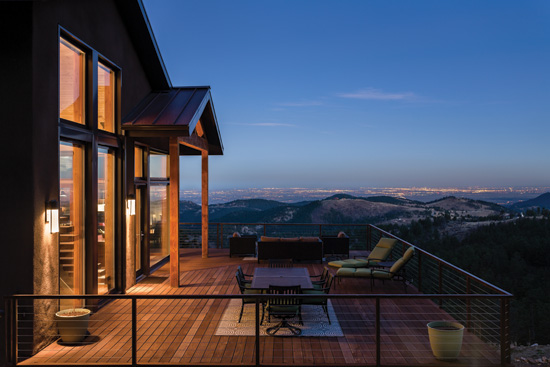
Photo courtesy of Zola European Windows
The growing use of European-made windows in the United States reflects both increasing interest in tilt-and-turn hardware as well as better componentry and thermal performance.
With frames and insulated glazing units (IGUs) manufactured in shops and factories in Germany, Poland, and elsewhere, “European windows” should not be conflated with “European-style windows,” which may be tilt-and-turn or similar products manufactured anywhere. The European-made windows and doors benefit from a controlled component supply infrastructure and exhibit performance levels generally higher than European-style products made outside of Europe. The hallmarks of European fenestration assemblies include sophisticated glazings, complex construction and better-quality frames, gasketing, and hardware. This specialty market segment is currently estimated at about $200 million.
Of course it's only one part of the equation, but a big step toward better performance. As Frank Lloyd Wright once quipped, “You can't make an architect,” with the metaphorical rejoinder, “But you can...open the doors and windows toward the light as you see it.”
Driving Better Performance
A chain is only as strong as its weakest link, and buildings can only be as efficient as their least effective systems. This truism is all the more inescapable when the aim is the most sustainable, most energy-efficient structure practical given other programmatic and design requirements. In fact, the push for net-zero energy buildings and Passive House performance has led to an “arms race” of sorts to create better architectural assemblies at what are considered the building's inherently weakest points: the envelope, air barriers, joints and interface zones, and fixed penetrations and operable openings.
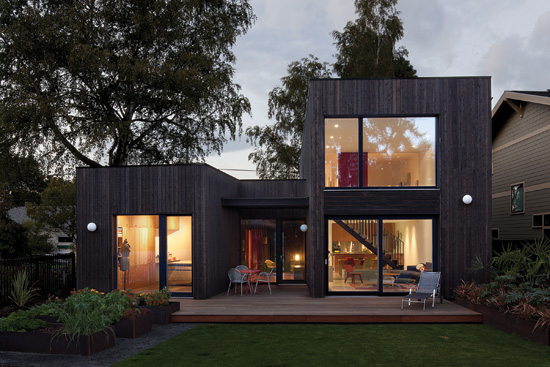
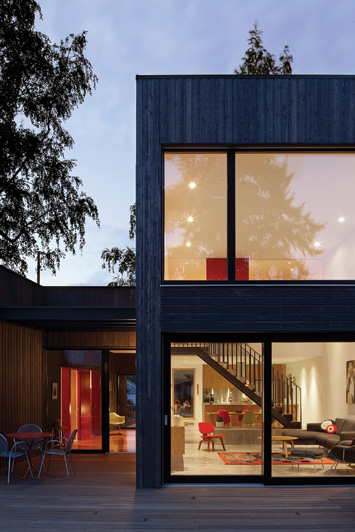
Photos courtesy of Zola European Windows
For this modern home, sliding doors and large European windows are employed to create very large openings with high visible light transmittance, low SHGC, and good overall R-values.
In fact, in many circles, better windows are seen as the key to better architecture. Consider the requirements for Passive House windows; the Darmstadt, Germany-based Passive House Institute requires that “window frames must be well insulated and fitted with low-e glazings filled with Argon or Krypton to prevent heat transfer. For most cool-temperate climates, this means a U-value of 0.80 W/(m²K) or less, with g-values around 50 percent.” That's a lot to consider:
Low-E or low-emissivity glazings have coatings that minimize ultraviolet (UV) and infrared (IR) light transfer through the glass without limiting the amount of available visible light.
Argon and Krypton gas fills are pumped into double- and triple-glazed IGUs to reduce convective currents and thus thermal transfer through the window.
U-value—also called U-factor—measures the rate of heat transfer through a construction assembly. Given in Btus per square foot per hour for every degree Fahrenheit difference in temperature (Btu/h·ft²·°F) or, in Europe, watts per square meter by degrees Kelvin, the lower the U-factor, the better the window insulates, and 0.25 is a decent value in U.S. units. The aggressive Passive House benchmark is 0.80 W/(m²K), which is equivalent to 0.14 Btu/h/ft²/°F, a super-high-performance criterion that many U.S. window makers have not attained with commercial-grade offerings.
Last, g-value, the measure for total solar transmittance and sometimes called solar factor, window solar factor, or total energy transmittance (TET), is a prevalent specification in Europe. In the United States, solar heat-gain coefficient (SHGC) is used, measuring the solar energy transmittance of a window or door as a whole. This describes the proportion of solar energy available on the indoor side of the window, and SHGC is expressed as a number between 0 and 1 where lower values mean less solar heat is transmitted through the assembly.
It's important to note that SHGC includes not only solar energy transmitted directly through the glazing area but also solar energy absorbed by the glazing that is then thermally radiated inward.
For all these measures, the key is to consider how the Passive House standards and other European regulations diverge from normative building standards and prevalent U.S. energy codes. “We are seeing an exciting trend towards more widespread interest in high-performance construction,” says Katrin Klingenberg, executive director of Passive House Institute U.S. “The number of Passive House and building projects that are completed every year is steadily rising. Currently there are over 230 projects fully certified or enrolled in the certification process across the U.S. and Canada. Implementing windows with outstanding thermal performance and airtightness is a key component of achieving these levels of performance.” The expectations are higher, the performance ranges much more restrictive, and—as many architects judge—the quality of window construction is higher and subject to more restrictive tolerances.
Fixation on Window Performance
Why are windows such a critical focus of European standards? While architects have an intuitive sense of why glass apertures in an otherwise opaque enclosure mass would have an outsize impact on thermal conditions indoors, a simple illustration shows exactly how dramatic that impact can be.
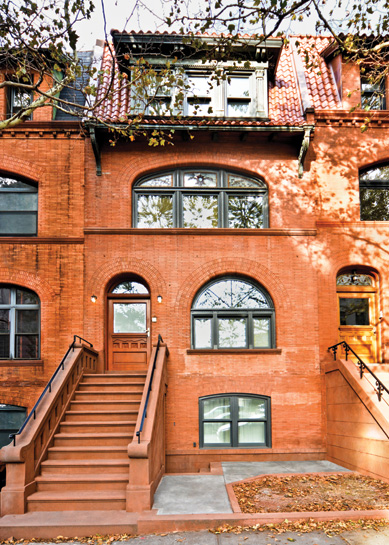
Photo courtesy of Zola European Windows
European windows can also be used for high-performance applications in urban historical retrofit projects.
Consider a subject vertical wall segment that has an insulating value of about R-50. Now add to the design around 15 percent glazing area. If the design employs ENERGY STAR-certified windows—with an insulating value of R-3 and meeting EPA-mandated performance levels that became effective in January 2015—the total wall R-value for this assembly drops from R-50 to R-15, a 70 percent reduction in performance, as shown in an analysis by the Seattle-based contractors Hammer & Hand. To compensate, let's say the architect designs an improved wall construction so that the opaque area reaches R-100. That's good news but rather ineffective, because it results in a total R-value of only R-17—only a 2 percent improvement over the R-50 wall example above.
It is such a slight improvement, in fact, that the designer's attention should have been on improving the fenestration performance instead. The fact that ENERGY STAR windows meet only modest energy standards is beside the point. Rather than meet ENERGY STAR, the project architects should exceed those performance levels and specify better windows that meet higher-performing European construction standards. With a better window with an insulating value of R-8, the original R-50 test wall segment can yield a whole-wall insulating value of R-38—a significant improvement over the R-15 one might achieve with lower-performing R-3 windows.
Key to the better performance levels? The R-8 product will have deep frame profiles with engineered thermal breaks using double- or triple-glazing, with gas-filled IGUs.
In addition, a range of opening types, design options, and functionality are available with recent European fenestration products. One of the most discussed in the last few years are tilt-turn windows. “These windows can both swing inward and tilt inward with a simple turn of an ergonomic handle,” says Florian Speier, founder of the Steamboat Springs, Colorado-based manufacturer Zola European Windows. “Tilt-and-turn windows can be very large, with each sash up to 5 feet wide, using multi-point locking mechanisms for both safety and effective air sealing.” While U.S. end-users are more familiar with basic sliding, casement, and double-hung window types, the tilt-turn is growing in market share. Unlike casements, tilt-turns don't have crank handles; common wood finishes include pine, oak, and meranti, which is similar to mahogany.
Tilt-turn windows and other European opening types, such as lift-slide doors, are engineered to accommodate moving sashes that are substantially larger than their domestic counterparts. Given that larger units are typically specified, the somewhat wider European frames become very slender in proportion to the window size. Nonetheless, some European manufacturers have pushed to minimize frames as much as possible in recent years.
For example, one concealed sash window—a tilt-turn type for openings up to 5 feet by 8 feet—is often seen in thin, aluminum-clad wood frames that completely hide their concealed hinges and sashes. The slender frame helps to maximize views out, and the hidden sashes help architects design continuous glass lines on façades regardless of whether the windows are fixed or operable. In this way, fixed windows and tilt-and-turn windows are indistinguishable from the exterior, keeping the look sleek and crisp.
Another related type of fenestration that is still popular in many U.S. markets is the casement window. “Casements are sometimes preferred because end-users want a window that swings out, so some European window makers are producing high-performance versions,” says Speier. “But they come with the limits of smaller sizes as compared to tilt-and-turn products due to design wind loads.”
There's no such concern for fixed windows, which present a very cost-effective method for implementing large glass areas. Some of the European-designed products offer fixed openings of up to 100 square feet or glass area that are covered by normal manufacturer warranties. In addition, European designed sliding doors and folding doors are finding more applications in the United States. These door designs have a unique hardware assembly: rather than sliding in their seals like many American types, the European sliding doors are lift-slides or similar constructions that move the operable element away from the seal before it slides. In this way, highly airtight compression gaskets can be used. Widths of up to 20 feet are possible with two large glass panels (and no dividers).
Even larger sizes are possible with more than two panels. For example, a triple-panel or quad-panel design can extend as far as 60 feet across.
Last, European designed window products include Passive House windows, as mentioned previously, which by definition are certified by Passive House Institute U.S. (PHIUS) or Passive House Institute Germany (or, in rare cases, both). The PHIUS certificates show climate-specific recommendations for the certified windows—on south-facing or north-, east-, and west-facing façades—as well as lists the whole-window installed U-values and the center-of-glass (cog) U-value, or Ucog-value. This measure describes heat gain or loss through the glazing without taking into account the effect of the frames or size of the glass. Lower values represent better insulation, and it is the reciprocal of R-value and Rcog-value, where a higher value is better performing.
Based on recent certificates issued by Passive House Institute U.S., a quadruple-glazed European window design with a Krypton fill and an SHGC of 0.456 can achieve a whole-assembly installed U-value of 0.11 or 0.12 Btu/hr.ft2.F and a Ucog-value of from 0.056 to 0.064. “These installed U-values include the significant losses at the wall-to-window junction,” says Speier, “a loss that can be mitigated by the architect with careful installation detailing.” For comparison, the standard triple-glazed window with Argon fill (also PHIUS-certified) has an SHGC of 0.529 and achieves whole-assembly installed U-values of 0.14 to 0.16 a Ucog-values ranging from 0.096 to 0.119.
In all cases, the window products will allow building designs consistent with the requirements for thermal control and reduced air infiltration as required by the Passive House Institutes.
Start with Glass Selection
For performance levels like those achieved with these certified Passive House windows, experienced architects tend to start with a general idea of performance needs and budgets for major building components. What allowances for European-style windows are needed for project planning? Are triple glazing or quad glazing allowed by the budget and overall client expectations? If they are consistent with performance needs, the answer is likely yes.
“We had done some significant investigation into the possibility of getting higher-quality, higher-performance windows than we could find in the United States for our Passive House- and energy-driven projects,” says Brian Fuentes, AIA, CPHC, principal of Fuentes Design in Boulder, Colorado. “We have been able to successfully help our clients install higher-performance Euro windows here in Colorado, even at high altitudes.”
In general, project design development should pay extra attention to glass and IGU selection variables and expected performance. This includes such functional needs as acoustics, interior daylighting, and exterior visibility and, if needed, security or ballistics performance. Second, zoom in on glass performance based on the raw measurements by the manufacturer: These are mainly U-value, SHGC (high solar heat-gain vs. low-gain glazings) and the related variables of light transmittance (VT), reflectance, and absorption. These three light variables will be compared to the SHGC values as part of balancing the value of interior natural light against anticipated heat gain—some wanted, some not.
Next, there are glass treatments and options that will affect the ultimate specification, such as low-emissivity coatings. Most coatings are thin layers of metal applied to the glass just after manufacture or during finished glass fabrication to improve solar performance or change the reflectivity of the glass surface. Mirrorlike reflective coatings were among the earliest coating types, and they helped cut heat gain simply by reflectance. This also reduced light transmission, often to unacceptable levels. Contrast this with low-E coatings, which reduce heat transfer but preserve higher levels of light transmission.
IGUs for today's high-performance windows are typically designed with multiple glass panels, and various coatings including low-E products are applied (or deposed) onto only the glass surfaces that produce the best possible results. In many cases, a combination of low-E coatings, sometimes with reflective coatings, will provide the best performance in terms of thermal and visual needs. Each glass panel has two sides, so a double-glazed IGU has four glass panel surfaces that could receive coatings; similarly, a triple-glazed IGU has six, and a quad-glazed window has eight. Each glass ply surface is designated by a number, with the surface at the exterior of the building always referred to as surface #1; the back of this ply is surface #2. The low-E and reflective coats, if any, are applied to the surfaces that provide the optimal physics of visible light transmission and heat gain.
Triple glazing is increasingly seen in North America, while the quad-glazed window is an emerging spec. The question is, does the fourth glass ply add enough value to bother? The answer may be yes, say experts like Speier. “Using triple glazing is a no-brainer because the additional cost is very small and the glass insulates nearly twice as well as double glazing,” he says. “Quad glazing is another big step forward; however, at current cost levels it typically only makes sense in colder climates.” In warmer climate zones, where solar heat gain is less desirable as enclosures are engineered to keep heat out most of the year, the lower SHGC and good thermal resistance of triple-pane windows are effective.
While the three cavities of quad glazing is inherently superior to two cavities—each chamber reduces convective currents and thermal transfer—the question in all projects is, “How superior?” Over time, the quad glazing pays for itself according to life-cycle analysis (LCA) studies; depending on project variables, a payback period of five to 12 years can be expected.
Gas Fills for IGUs: Argon and Krypton
The performance of the double-, triple- or quad-glazed IGUs that are used in the building project depend on how the cavities are filled. The use of inert gases—often called low conductivity gas fills—improves the performance over simple air fills. The low-E coating handles the radiant component of heat loss/gain, while the conductive heat movement or gas-phase conductivity remains; the gas fills help handle that second effect.
While air can reduce some conductive effect, its thermal conductivity is 0.014 Btus per square foot per hour for every degree Fahrenheit difference in temperature (Btu/h/ft²/°F); compare this to Argon, which boasts a conductivity that is about a third less, at 0.0092. Argon is a common gas fill, but Krypton is also used and its conductivity, at 0.0051, is about 63 percent lower than air alone, according to Green Building Advisor. Other gases may have a lower conductivity—such as the rare gas Xenon, which conducts heat at a rate about 79 percent lower than that for air—but their cost and practicality for use are not yet established.
In general, experienced architects view Argon as the more cost-effective gas, while Krypton can offer high performance in certain situations. For example, Krypton tends to be more effective in narrower spaces, such as in the smaller gaps between glass plies in some IGU designs of around 3/8 inch. Most double-pane windows have Argon fills, which works well with the relatively large gap between glass plies—around 1/2 inch between the panes. For these reasons, Krypton is used in some quadruple-glazed European window designs, as it is more effective in the narrower space. Experts note that if the window has a wider space between the glass panels, Argon is just as effective, and the wider space will give a higher IGU performance at less extreme temperatures.
Current-generation European frames can carry IGUs just over 2 inches thick, which accommodate either Argon-filled, triple-glazed glass at optimum 5/8-inch to 3/4-inch gaps, or quad glazing with smaller cavities, which then requires Krypton for optimum performance. Domestic, U.S.-made windows can typically carry IGUs of up to about 1 inch; to optimize performance, these tend to use Krypton fills.
Today's manufacturing technology has helped to improve the performance of inert gas fills. In some cases, for example, the design R-values and U-values of gas-filled IGUs have been compromised by fabrication and installation practices. Manufacturers shipping cross-country, for example, fit their windows with breather tubes installed, which allows the interpane spaces to reach equilibrium with the outdoor air pressure. This helps prevent breakage, bowing, and seal failures while traveling over high-altitude passes, but in some cases it has led to unacceptably high losses of the low-conductivity fill gases. Today, however, some European window manufacturers use more advanced pressurization systems to ensure the window performs at the rated performance even for very high-altitude locations and transport.
In addition to the use of inert gases for energy savings, the glass itself may require certain performance characteristics that affect specifications. Laminated glass—where two or more panes of glass in the IGU are bonded together by a durable plastic interlayer—offers strength and safety features ideal for resistance to hurricanes, missile impact, explosions, and forced entry. Perhaps more broadly applicable, laminated glass can provide excellent acoustical isolation and reduce sound transmission. Both laminated glass and hardened tempered glass, often called “safety glass,” may be required by code:
▶ for any doors
▶ where the bottom edge is less than 18 inches from the floor
▶ where any edge of the glass is within 36 inches horizontally of a walking surface
Also, windows adjacent to any doors and walking surfaces or near stairways, landings, and ramps may require tempered glass under certain conditions.
Appearance and Aesthetics: Low-Iron Glass
Of utmost importance to most architect, however, are two variables that European window products have addressed: performance and appearance. While the thermal profile of a window may be critical to energy efficiency, today's designers also demand excellent light transmission, clarity, and visual consistency.
One of the major improvements to architectural design in recent years has been the use of low-iron European glass, which has less of the naturally occurring tint found in standard float glass. As implied, this glass formulation has a lower iron oxide content—usually about one-quarter of the amount used in normal float glass—giving it what Mother Nature Network called “water-white clarity,” ideal for framing artwork or for floor-to-ceiling windows. The crystal-clear, highly transparent glass offers another bonus of improved acoustic performance.
In addition, low-iron glass is inherently more energy efficient than other glass types. The panels absorb less IR energy, so they stay cooler when exposed to direct sunlight, yet they also transmit light very efficiently, so there is some associated thermal gain in the building interior. The glass is favored for building-integrated photovoltaic (BIPV) systems, in part because of the good levels of visible light transmission (VLT). Yet the glass panes are similar to any float glass in material composition and recyclability.
Overall, low-iron glass makes a strong case for aesthetics, performance gains, and environmental friendliness. It is increasingly a popular specification for European window designs and projects meeting high-performance expectations.
Window Ratings: Understanding NFRC
Regardless of the glass, fill, and frame materials selected, most windows and skylights in the United States have a label indicating their baseline performance as verified by the National Fenestration Rating Council (NFRC). The labels list U-factor, SHGC, visible transmittance, and air leakage. While NFRC ratings and their familiar labels seen on new products help assure conformance with building codes and energy codes, they are similar to those codes themselves: They set only a minimum performance level.
More to the point, the NFRC values are based on a window size of approximately 4 feet by 4.5 feet. Given that glass will always outperform the frame, if the architect implements larger sizes in the building designs, the resulting window assemblies can achieve performance levels that are far greater than the NFRC stickers display.
European windows are designed and engineered to be made in very large sizes, so this unique opportunity to exceed the NFRC label performance levels has been seen by some architects and their clients as a good reason to use European windows at large sizes.
In addition to this strategy for using windows to achieve high performance, the NFRC identifies “beyond-code programs” in its literature, referring to green codes and “stretch” energy codes given in many jurisdictions. Some of these become new minimum codes in those states and cities, while some offer developers incentives or rebates to meet them.
Other beyond-code programs require more or better high-performance fenestration. These include LEED certifications, Living Building Challenge, and Passive House guidelines. Compare a window with an NFRC sticker to a European window product that meets PHIUS baseline performance:
Criterion (*typical values) |
NFRC* |
PHIUS* |
|---|---|---|
| U-factor | 0.20 – 1.20 |
0.14 – 0.16 |
| SHGC | 0.25 – 0.80 |
0.48 – 0.62 |
| VT | 0.20 – 0.80 |
0.74 |
| Air leakage | 0.1 – 0.3 cfm/sq. ft. |
0.03 cfm/sq. ft. |
According to the trade group Efficient Windows Collaborative, the NFRC sticker displays ratings for the whole window, including glazing, frame, and spacers. This overall window value is important to know, and again, the window performance variables will vary greatly depending on how big the window is. Architects seeking improved performance and greater energy efficiency consider all of the components together, based on the size of the opening and the expected U-factor, heat gain, and VT.
European designed and fabricated windows tend to have better performance to meet the needs of Passive House or other “stretch standards.”
It’s All in the Install
Even the world's best windows can't overcome a poorly crafted installation designed by an inexperienced architect or mounted by an inexpert contractor, however. “The junction of window and wall is quickly becoming one of the most important, if not the most important, remaining weak spot” for high-performance architecture, says Zola's Speier. The window-wall interface, detailed with continuous insulation (ci) and properly flashed and sealed air barriers, is essential to meeting energy-efficiency goals.
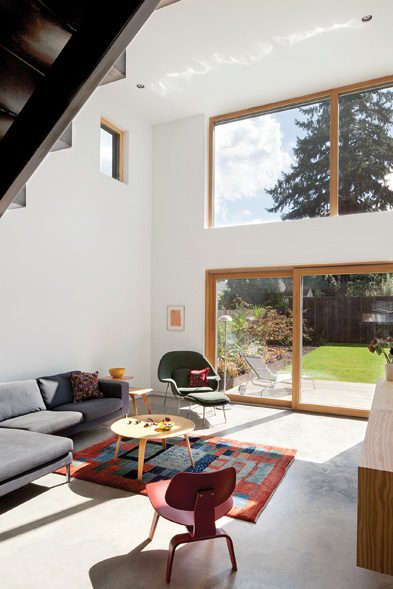
Photo courtesy of Zola European Windows
This modern home interior, with European windows, shows how even very large openings are used, reflecting improved comfort for occupants while increasing available daylight and controlling solar heat gain to desired levels.
This means the end to some commonly used construction practices that limit effectiveness, such as nailing flanges, outside flush installs and pans to set the window on, says Speier. A new set of tools and techniques is required, and architects need to understand the implications of moisture management as much as the other commonly reviewed window specs.
Better installations are more than a matter of opinion. Installation performance—given as a variable Ψinstall or “Psi install” in building science literature such as Passive House standards and European energy-efficiency handbooks1—is the measure of the linear thermal bridge at the junction of the wall and the window frame. The measure Ψinstall accounts for all additional losses or unexpected gains that make the installed window performance differ from the simple calculation window thermal efficiency—for example, X square feet of R-50 wall and Y square feet of an R-8 window equals the total assembly performance of, let's say, R-37. This assumes a zero Psi install (Ψinstall); but if it's a positive Psi install, that means there are additional thermal losses to consider.
Design considerations include the window's position in the envelope. For example, if the window is flush to the building exterior, it will generally have worse performance (Psi install) than if the window is centered within the wall section. But any installation position will introduce new heat flows and, therefore, inefficiencies; for this reason, some architects detail the opening with additional foam insulation mounted on the outside and inside of the window—in effect, overlapping the wall and the window, which yields better performance than the simple sum of window and wall.
In general, the wall section should be reviewed to ensure there are no thermal bridges; if the design team sees steel or concrete penetrating through the envelope, performance losses will be significant. The window should be centered and “over-insulated” to earn significant increases in the structure's thermal performance of the building.
How do Ψinstall considerations affect the architect's design and contractor's work? There are basically three phases that characterize the high-performance install from the merely adequate or subpar:
Rough opening preparation. As compared to an outside, flush installation, locating the window at some midpoint in the envelope means the rough opening must be carefully detailed. Exposure to water is expected, and flashing tapes should be combined with careful returns of the flashing and façade materials. Highly effective are vapor permeable, fluid-applied flashing materials, which are less prone to problems in the corners of the rough opening. (They also eliminate the potential errors in applying flashing tapes, such as poor lapping.) Good flashing ensures continuity of the airtight layer in the enclosure. “A conventional window install involves dozens of potential failure points for reverse lapping or air leaks. We've eliminated all of that in favor of a seamless, more foolproof system,” says Sam Hagerman, co-owner of Hammer & Hand and president of the Passive House Alliance U.S.
Window install. There are four steps in the window installation itself: structural attachment to the wall assembly with screws or clips, waterproofing to the rough opening, insulating between the window frame and the rough opening edges, and making the interface airtight. Tapes and sealants provide for the waterproofing, gap insulation, and airtight connection. But “filling the gap” must be done with care; this is like a miniature wall assembly that must be able to dry either to the inside or outside, depending on the climate zone. So tapes made for outside waterproofing and inside airtight connections are different, engineered to create a proper mini-wall, not a “vapor-barrier sandwich.” Filling with low-expansion foam increases thermal performance better than a hollow gap.
Over-insulation. This refers not to excessive insulation but rather adding a layer of insulating material at the window jamb and over a portion of the window frame assembly. Depending on the window design, hardware location, frame cladding, and swing direction, overinsulation can be a valuable way to improve thermal performance. In some cases, up to 3 inches of exterior insulation can be added to the exterior of European tilt-and-turn windows, covering most of the frame area. Other windows with recessed aluminum cladding can be detailed with overinsulation connected directly to the wood subframe. The overinsulation can be applied to the interior side of some windows if room allows for proper and comfortable hardware operation, but some window assemblies—such as outswinging models—may not allow for exterior overinsulating.
In these ways, installation details affect the building's overall energy performance and environmental impact. Seemingly minor adjustments at the window-wall interface actually have a significant impact on carbon footprint.
Passive House Analysis and European Windows
In studying the results of such projects, project teams can choose to analyze their results using methods presented by the Passive House Institute U.S. (PHIUS) as well as using products certified by PHIUS. The institute's program for projects is called PHIUS+ Certification, which combines a design verification protocol with a closely monitored program of quality assurance and quality control (QA/QC) performed on site by qualified PHIUS+ raters.
The Passive House certification process includes the design review and an analysis of the project's energy model to identify any potential errors or areas of improvement. Modeling and calculator tools, such as WUFI Passive, allow for both static and dynamic modeling and hygrothermal analysis. Following construction, the projects are tested and inspected by Home Energy Rating System (HERS) Raters, who are certified by the Residential Energy Services Network, known as RESNET. These inspectors are trained to score the projects using the RESNET HERS Index, which many local, state, and federal financial incentive programs require to demonstrate compliance.
The scoring system is based on a reference home based on the 2006 International Energy Conservation Code (IECC) with a HERS Index of 100. Compare this baseline to a net-zero energy home, which scores a HERS Index of 0—so the lower a home's HERS Index, the more energy efficient it is. Each 1-point decrease in the HERS Index corresponds to a 1 percent reduction in energy consumption over the reference home, according to RESNET; so, for example, a building with a HERS Index of 75 is 25 percent more energy efficient than the baseline, IECC-compliant reference home.
In addition to the design modeling tools, many project teams are using imaging and visualization tools to better understand window performance in the schematic and design-development phases. For example, tools like AnTherm can calculate temperature distributions and heat flows in building structures, with particular benefit for identifying thermal heat bridges. Some of the required inputs have already been handled by manufacturers of European-style windows, including the section geometry, thermal conductance and transfer coefficients, and boundary conditions such as air temperatures and U-values.
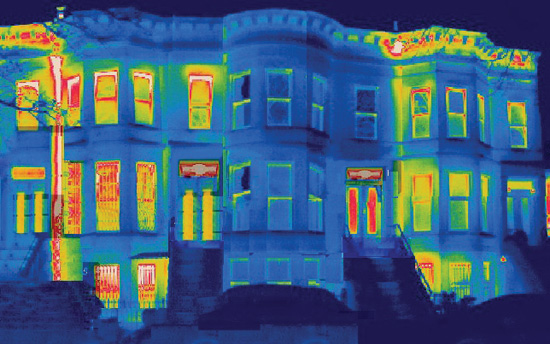
Image courtesy of Zola European Windows
Thermal imaging shows areas of heat loss in an older townhouse building. High levels are seen at the windows, doors, and window-wall interface, as well as the roof-wall interface behind the cornice. The house in the middle was retrofitted with high-performance European windows, and this thermal image shows significant reductions in energy loss.
With these tools, architect can easily see and compare the performance of wall sections and window products. One team recently studied the heat-flow characteristics of highly insulating European-made windows for a new building project, the Amethyst Passive House in Colorado. In another instance, a project team in New York City studied the effectiveness of a retrofit window by comparing visualizations of thermal heat flows of the original windows and the high-efficiency, European replacement windows.
Conclusions: High-Performance and European Windows
In general, the best-performing house and building designs will meet such strict, beyond-code standards as Passive House and Living Building Challenge. Additional certifications and ratings may help ensure the projects are even more sustainable—for example, the use of Forest Stewardship Council (FSC)-certified wood for components such as wood window frames. But the core attributes of high-performance buildings include energy efficiency, effective insulation, and reduced air infiltration, among other key measures.
For those projects where energy savings and occupant comfort matter most, key to design is specifying and designing window installations for superior thermal performance and airtightness. A number of European fenestration products meet and exceed the strictest energy codes, using effective and lasting technologies in window and door construction. Key variables to review for European window selection include:
Low overall U-values. These can be as low as 0.123 for triple-glazed units, although quad-glazed versions have achieved 0.09.
Airtightness. In general, specifying triple seals will help achieve a very tight envelope and limit unwanted air infiltration or exfiltration.
Novel glazing options. A growing number of manufacturers offer triple and quad glazing, as well as Argon- and Krypton-filled IGUs of up to 54mm.
Premium hardware. Selection of high-quality hardware is important to premium window performance, ensuring tight closure and long-term durability. Tilt-and-turn has been favored recently for its reliable performance.
Effective frames. Center-of-glass (CoG) values for window performance tell only half the story; frames must also allow for energy-efficient operations. Review available frame types, designs, and insulating materials; seek to eliminate any thermal bridging.
Spacers. Warm-edge spacers are a requirement for high-performance windows, according to experts in sustainable design and Passive House standards.
With these conditions met, architects can better address the multiple, interrelated ways in which fenestration products affect building performance and energy efficiency.
It is critical to view current energy codes—and NFRC ratings and labels—as important, but only as a baseline performance indicator. It indicates that there has been a base level of review, product inspection, and testing, but does not guarantee that windows achieve high performance levels such as those required for the Passive House certification. More important is to look for windows that achieve tested performance levels that meet specific prescriptive and performance-based design criteria. Ultimately, better thermal control, SHGC, and visible light transmission will help the projects achieve better overall operations criteria and top certifications.
Among the most visible trends in architectural design is the use of European designed and manufactured window technologies to elevate the level of building performance. Among these product solutions are European tilt-turn assemblies and European casement and fixed fenestration that display markedly different construction and materials as compared to normative, domestic-made windows. As with other advances in construction methods and components, energy-efficient windows that address occupant comfort and need have become a hallmark of building performance for many leading U.S. architects.
Endnote
- Energy Efficiency Solutions for Historic Buildings: A Handbook, edited by Alexandra Troi, Zeno Bastian (EURAC research)
C.C. Sullivan is a marketing communications consultant specializing in architecture and construction.
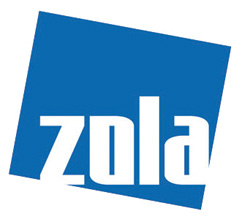 |
Swiss-trained architect, Florian Speier, founded Zola Windows in 2011. Unsatisfied with the domestic selection of windows, Speier partnered with European manufacturers to design extremely energy-efficient windows and doors. Zola offers extensive product lines—from the top-of-the-line Passive House ThermoPlus Clad, to budget-friendly uPVC windows that are perfect for multifamily developments. www.zolawindows.com |
